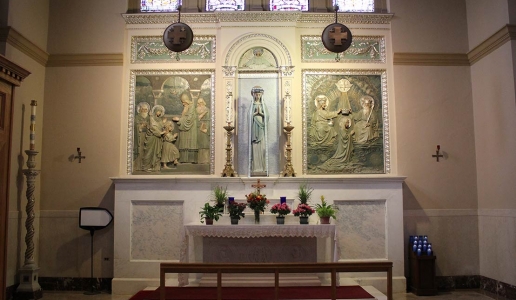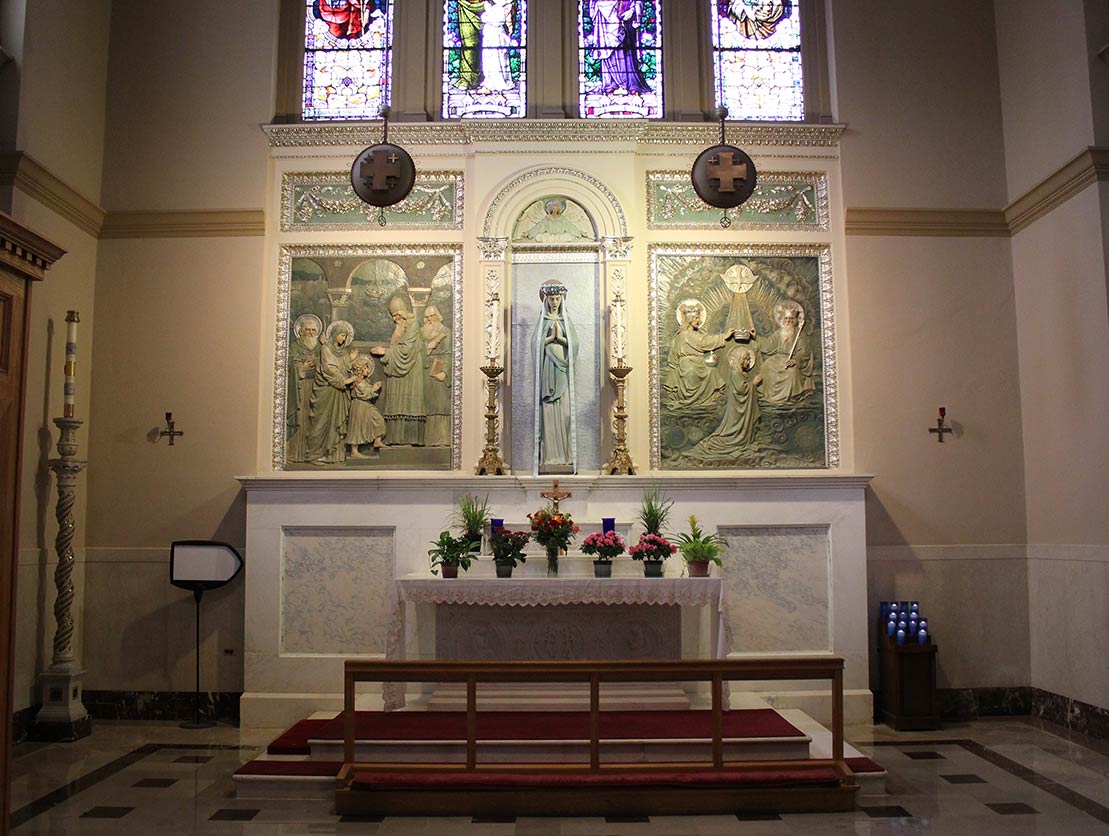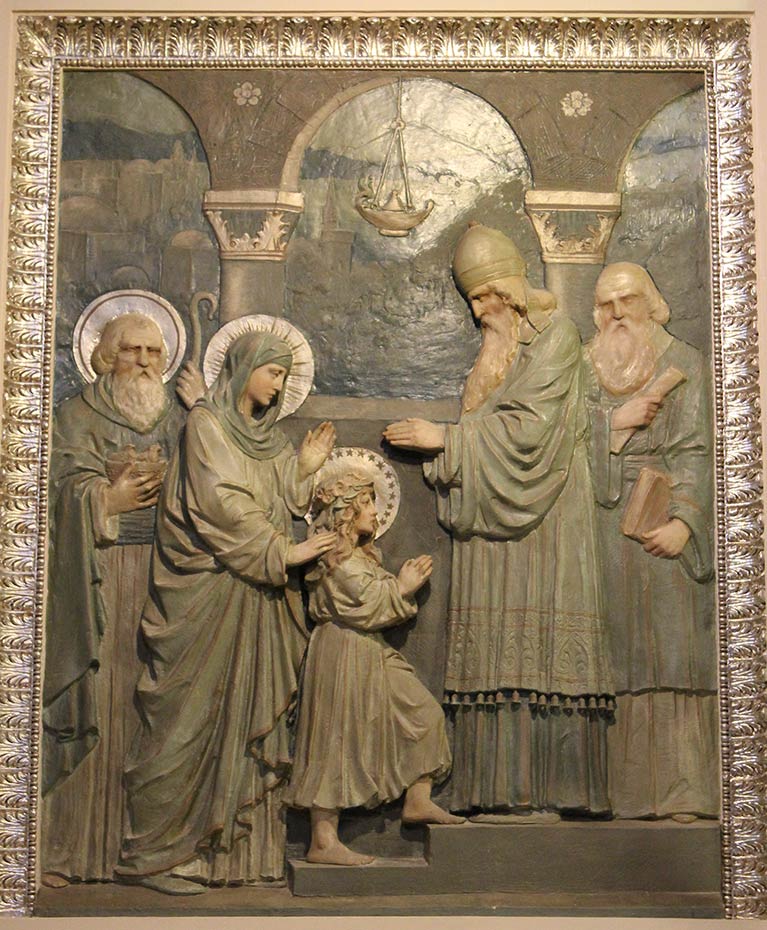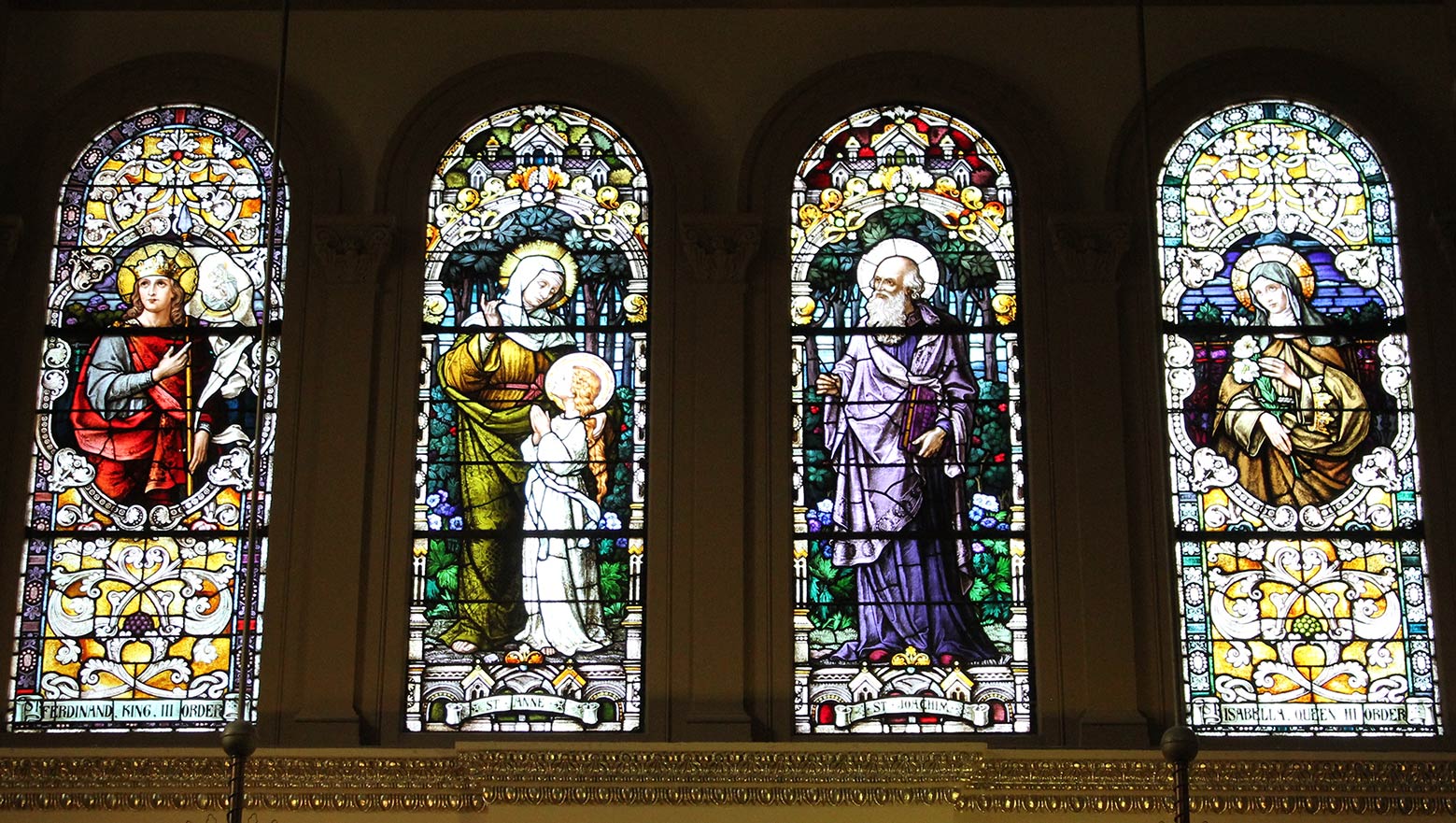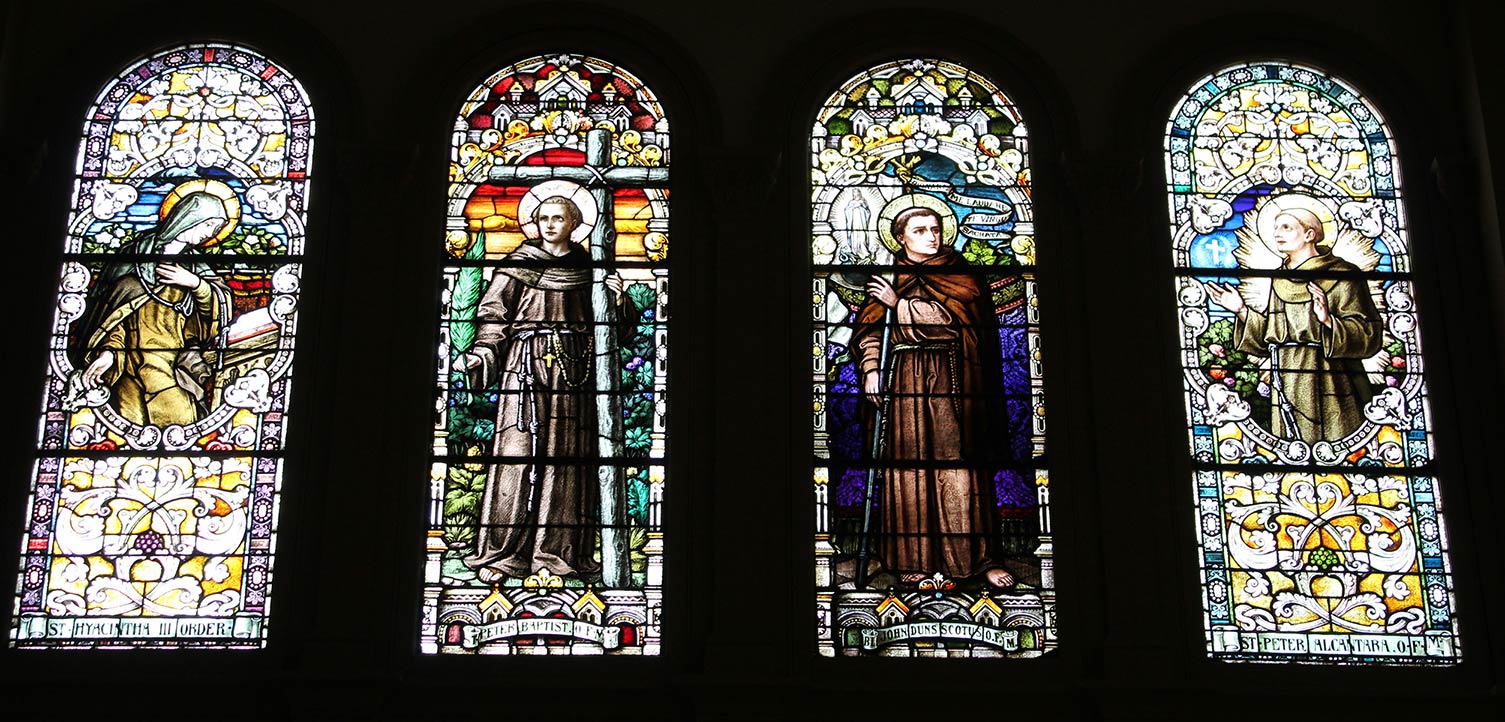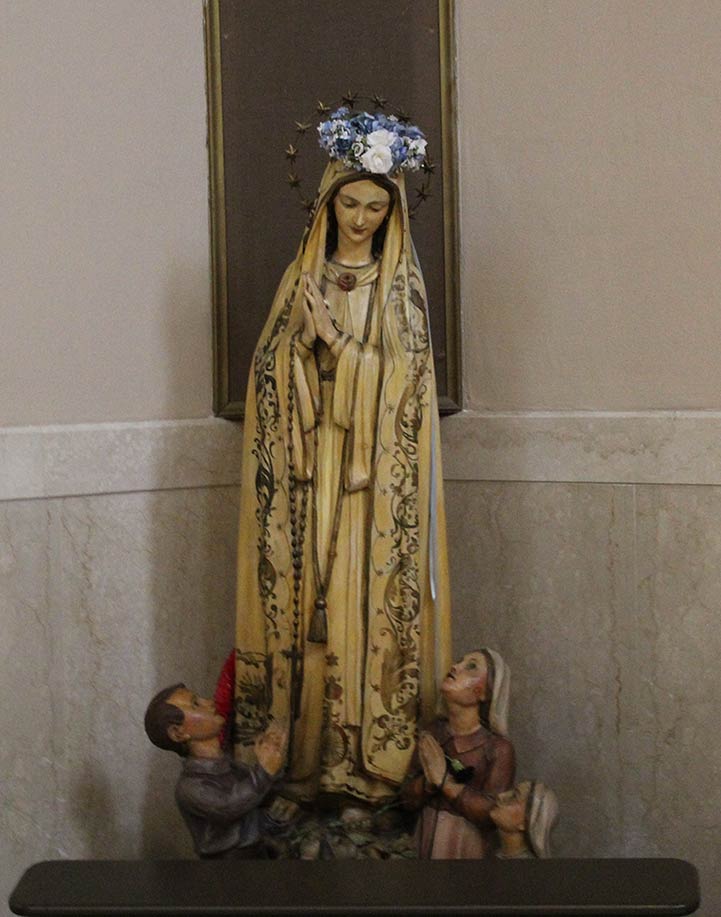Chapel of Our Lady of the
Immaculate Conception
Franciscan Monastery of the Holy Land in America
Location: 1400 Quincy Street NE, Washington, DC 20017
Metro: Red line to Brookland/CUA (15-20 minute walk; or take the H6 bus from Brookland station to the corner of NE Quincy Street and NE 14th street).
by Julián D. Ortiz-Santiago
Novena Prayer in honor of the Immaculate Conception
Immaculate Virgin Mary, you were pleasing in the sight of God from the first moment of your conception in the womb of your mother, St. Anne. You were chosen to be the Mother of Jesus Christ, the Son of God. I believe the teaching of Holy Mother Church, that in the first instant of your conception, by the singular grace and privilege of Almighty God, in virtue of the merits of Jesus Christ, Savior of the human race and your beloved Son, you were preserved from all stain of original sin. I thank God for this wonderful privilege and grace He bestowed upon you as I honor your Immaculate Conception. Look graciously upon me as I implore this special favor: (Mention your request). Virgin Immaculate, Mother of God and my Mother, please intercede for me as these prayers now rise before God. Filled with confidence in your goodness and power, I ask you to help me in this journey of life and to preserve me from all that is displeasing to God. I entrust myself entirely to you, knowing that you will help me to avoid sin and to always live a humble and pure life. I consecrate myself to you forever, for my firm desire is to love your Divine Son Jesus. Mary, since those devoted to you have never been known to perish, pray that I too may be saved. Amen.
The Chapel of Our Lady of the Immaculate Conception is located within the main church of the Franciscan Monastery of the Holy Land in America. The main church was founded in 1898 by Fr. Charles Vassani and Fr. Godfry Shilling. The hope of the priests was to build a church that had replicas of Holy Sites from Jerusalem, the Holy Land for Christians, Jews, and Muslims. They employed architect Aristide Leonori to design the church to house some of the replicas of the Holy Land, such as the tomb of Jesus Christ and Mount Calvary, where Jesus was crucified on the cross.1 Franciscan Monastery of the Holy Land in America, An Oasis of Peace Washington, DC http://www.myfranciscan.org/monastery/.Leonori included in his design of the church four side chapels in each corner of the church. Each chapel honors a saint that is especially important for the Franciscan Order. One of these side chapels is the Chapel of Our Lady of the Immaculate Conception, located in the northwest corner of the church (fig. 1).
The main draw to the chapel is the artwork above the marble altar. Immediately visible above the center of the altar is a statue of Our Lady of the Immaculate Conception (fig. 2). The statue can be identified as the Virgin Mary due to the traditional Marian clothing of a blue veil and white gown, but it does not have any particular iconography that sets it apart as a depiction of Our Lady of the Immaculate Conception. The statue depicts Mary solemnly facing downward with her eyes closed and her hands folded in front of her, as if in prayer. The crown of flowers adorning the head of Mary and the ribbons streaming from the crown are not part of the original sculpture, but were placed on the statue by the Franciscans that oversee the church.2 Peter, tour guide of the Franciscan Monastery, November 11, 2014.
On either side of the statue of Mary, there are relief sculptures depicting two scenes of Mary’s life. The scene on the left depicts the presentation of the child Mary to the temple (fig. 3). This story is not found in the canonical books of the Bible, the books on which the teachings of the Catholic Church are founded; rather, the story is found in the Protoevangelium of St. James. In the Protoevangelium, when Mary is three years old she is presented by her mother St. Anne and her father St. Joachim to the temple so that she may live there and be devoted to God. Seen here in the relief behind the child Mary are her mother and father presenting her to two priests of the temple.
The scene on the right depicts the Coronation of Mary as Queen Of Heaven and Earth (fig. 4). The Coronation of Mary is the fifth Glorious Mystery of the Rosary, a devotional prayer that commemorates events in the lives of Mary and Jesus Christ. In the relief one can see that Mary is being crowned by the Trinity, which can be seen from left to right as God the Son, God the Holy Spirit depicted as a dove, and God the Father. At the feet of Mary is a moon, a traditional iconographic motif expressing the queenship of Mary over the heavens.3 Melissa R. Katz Divine Mirrors, Virgin Mary in the Visual Arts (Oxford University Press, 2001) Pg. 186.
In the entirety of the church there are many stained glass windows that depict different saints; most, but not all, have some relation to one of the three Franciscan religious orders that St. Francis founded.4 Peter, tour guide of the Franciscan Monastery, November 11, 2014.In total, there are eight stained glass windows in the chapel of Our Lady of the Immaculate Conception. There are four stained glass windows above the statue of Our Lady (fig. 5), depicting from left to right: St. Ferdinand who was a king and a member of the third order of Franciscans, St. Anne the Mother of Mary, St. Joachim the father of Mary, and St. Isabella who was a queen and a member of the third order of Franciscans. The other four stained glass windows are located on the wall to the left of the altar above a wooden confessional (fig. 6). In order from left to the right, these saints are: St. Hyacintha of the third order, St. Peter Baptist, a member of the Order of Franciscans Minor (the first and most prominent Franciscan order), Blessed John Duns Scotus, member of the same Order and a chief defender of the theological belief in the Immaculate Conception of Mary5 New Catholic Encyclopedia, Vol. 5 2nd ed. (Gale, 2003) Page 334 s.v. “Immaculate Conception”., and finally St. Peter of Alcantara of the Order of Franciscans Minor and a founder of a reformed branch of Franciscans that had a much more strict vow of poverty and prayer.6 David Farmer, Oxford Dictionary of Saints 4th ed. , (Oxford University Press, 1997) Page 400.All stained glass in the church originates from Bavaria and was installed in 1931, 33 years after the church was built.7 Peter, tour guide of the Franciscan Monastery, November 11, 2014.
In the back right-hand corner of the chapel when facing the altar, there is a small statue of Our Lady of Fatima (fig. 7). Though the chapel is dedicated to Our Lady of the Immaculate Conception, the Franciscans currently in charge of the church thought that the Marian chapel would do well with a statue of the popular apparition of Mary that happened in Fatima, Portugal in 1917. The iconography identifying Our Lady of Fatima is the inclusion of three children, two girls and one boy, and the rosary that Mary holds in her hands. The children are Lucia, Jacinta, and Francisco, the only ones that were able to see these apparitions of Mary.8 New Catholic Encyclopedia, Vol. 5 2nd ed. (Gale, 2003) Page 663 s.v. “Our Lady of Fatima”
.The rosary is part of the image that the children saw in the apparition, as Mary revealed herself to them as Our Lady of the Rosary.9 Ibid, Page 664.There is a kneeler in front of the statue as an invitation to pray for the intercession of the Blessed Virgin, as well as a box for intentions and devotional candles to light.
For more information visit Franciscan Monastery.
References
| 1. | ⇧ | Franciscan Monastery of the Holy Land in America, An Oasis of Peace Washington, DC http://www.myfranciscan.org/monastery/. |
| 2. | ⇧ | Peter, tour guide of the Franciscan Monastery, November 11, 2014. |
| 3. | ⇧ | Melissa R. Katz Divine Mirrors, Virgin Mary in the Visual Arts (Oxford University Press, 2001) Pg. 186. |
| 4. | ⇧ | Peter, tour guide of the Franciscan Monastery, November 11, 2014. |
| 5. | ⇧ | New Catholic Encyclopedia, Vol. 5 2nd ed. (Gale, 2003) Page 334 s.v. “Immaculate Conception”. |
| 6. | ⇧ | David Farmer, Oxford Dictionary of Saints 4th ed. , (Oxford University Press, 1997) Page 400. |
| 7. | ⇧ | Peter, tour guide of the Franciscan Monastery, November 11, 2014. |
| 8. | ⇧ | New Catholic Encyclopedia, Vol. 5 2nd ed. (Gale, 2003) Page 663 s.v. “Our Lady of Fatima” . |
| 9. | ⇧ | Ibid, Page 664. |



